Pet Dental Month
 Lindsay Tracy, Redbarn Chew-A-Bulls
Lindsay Tracy, Redbarn Chew-A-Bulls
Lindsay Tracy is the Vice-President of Business Development at Redbarn. Redbarn is the underwriter of the Animal Radio Studios, and we're very proud to partner with them, especially for February, which is national pet dental health month.
Also in the studio is Ladybug, the Animal Radio Stunt Dog. This is because she heard Hal Abrams pick up a bag of Chew-A-Bulls from Redbarn and she came to get her treat, which she absolutely loves!
Lindsay explains that Chew-A-Bulls are treats in the shapes of fire hydrants, toads, shoes, brushes, chips and rings. They are easily digestible and made with limited ingredients. Each treat is also packed with antioxidants such as parsley and rich spices like cumin to support digestion and create an enticing scent. Another ingredient is miscanthus grass, a fairly new ingredient on the market, which Redbarn incorporates into their dental chews and their dry dog food. It's essentially an all-natural grain-free non-pea form of healthy fiber, used to support digestion.
 Chew-A-Bulls are designed with ridges and grooves to reach between your dog's teeth and gums. For example, the backside of the hydrant has little nooks and crannies, with is basically a crisscross design. What this does is allow the tooth to sink into those crevices and grooves, which then acts as a brushing mechanism. On top of that, they've designed it in a way to make it a harder and longer lasting chew. Each treat helps control tartar buildup, while gently massaging gums and scraping away harmful plaque. Chew-A-Bulls have no artificial colors, flavors, preservatives, or chemicals, which often you'll see in other dental chews on the market today.
Chew-A-Bulls are designed with ridges and grooves to reach between your dog's teeth and gums. For example, the backside of the hydrant has little nooks and crannies, with is basically a crisscross design. What this does is allow the tooth to sink into those crevices and grooves, which then acts as a brushing mechanism. On top of that, they've designed it in a way to make it a harder and longer lasting chew. Each treat helps control tartar buildup, while gently massaging gums and scraping away harmful plaque. Chew-A-Bulls have no artificial colors, flavors, preservatives, or chemicals, which often you'll see in other dental chews on the market today.
So why is it so important to take care of your pet's teeth? It's not just for vanity; there are also many medical reasons to care for your pet's teeth.
Periodontal dental disease is currently the number one diagnosed disease in dogs today. It is a progressive, cyclical inflammatory disease of the supporting structures of the teeth and is the main cause of dental disease and early tooth loss in dogs and cats. It affects over 87-percent of dogs and 70-percent of cats over three years of age.
Lindsay tells us that over half of all dog owners don't even know what to do as far as a daily dental regimen is concerned. Not only should you to go your vet yearly, but you should also think about your dog's teeth as much as your own teeth. So on a daily basis, you should either brush your pet's teeth or give them some type of dental chew that scrapes the tartar and plaque and massages their gums.
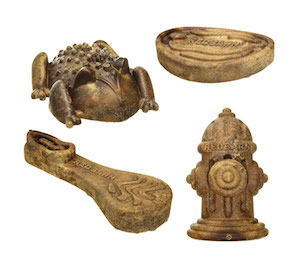 Unfortunately, poor dental health could lead to life-threatening conditions. Dental disease can affect your pet's liver, kidney and heart. It can also cause a loss of appetite and broken teeth. If bacteria get into an animal's bloodstream through diseased gums, a lot can happen and the longevity of your pet's life will be decreased drastically.
Unfortunately, poor dental health could lead to life-threatening conditions. Dental disease can affect your pet's liver, kidney and heart. It can also cause a loss of appetite and broken teeth. If bacteria get into an animal's bloodstream through diseased gums, a lot can happen and the longevity of your pet's life will be decreased drastically.
Chew-A-Bulls are a convenient way for an oral health solution. It's the best way to start your pooch's day. Lindsay encourages pet parents to also use these as a natural boredom buster treat. The nooks and crannies allow you to add things like peanut butter or yogurt, and then freeze them. You can also hide their pills or medications in them. Redbarn also offers low-calorie and low-fat treats as well.
Redbarn owns all of their own manufacturing facilities and they don't use co-packers. So they own the quality; they own the process; and they own the purchasing. So you know when you purchase anything from Redbarn, it's the best in class and made right here in the USA.
Visit Website
Is It Wrong To Love Your Pets More Than Humans?
Dr. John Huber, Clinical Forensic Psychologist
 Clinical Forensic Psychologist Dr. John Huber culled research indicating that, given the choice, we prefer puppies to people. Respondents to a recent survey are significantly less distressed when adult humans were victimized, in comparison with human babies, adult dogs and puppies.
Clinical Forensic Psychologist Dr. John Huber culled research indicating that, given the choice, we prefer puppies to people. Respondents to a recent survey are significantly less distressed when adult humans were victimized, in comparison with human babies, adult dogs and puppies.
In one study, students were shown fake newspaper clippings of a baseball attack on a puppy, an adult dog, a year old infant and a 30-year-old adult. The results of this study showed that the puppy and the baby were pretty much in a dead heat. However, the puppy and the adult dog definitely received more empathy over the adult. There was no question at all.
This is not surprising, because when you think about it, the one amazing thing about puppies and dogs, is that their love is unconditional. If you don't have the money for the best food, they don't care. They love you for who you are and there are not a lot of places in this world where we can get that.
And then there are things like crowd-funding. If you really want to raise money for something, an animal, especially a dog or a puppy, will get many more donations than humans.
Dr. Huber explains that we might love our pets more than people because it doesn't matter what kind of day you've had. You don't have to explain yourself when you're in a bad mood, they'll still love you. How many licks on the face does it take to get to the center of your heart? Forget the Tootsie Pop, they can put you in a better mood. The connection that we have with our pets is just amazing. We're blessed to have our four-legged furry friends.
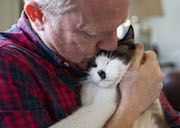 So does Dr. Huber think that we go to far by putting clothes on our pets? He understands when you want to dress them up for special occasions like Halloween, Thanksgiving and Christmas, but thinks it gets a little obsessive if you're dressing your dog up every single day. On the other hand, if you live in a cold climate, some dogs are just not meant for cold and you need to help protect them with coats and sweaters. So that's a little different. However, if you're spending money on clothes for your pet that would normally go to your food, for example, then you might need to come in and talk to him.
So does Dr. Huber think that we go to far by putting clothes on our pets? He understands when you want to dress them up for special occasions like Halloween, Thanksgiving and Christmas, but thinks it gets a little obsessive if you're dressing your dog up every single day. On the other hand, if you live in a cold climate, some dogs are just not meant for cold and you need to help protect them with coats and sweaters. So that's a little different. However, if you're spending money on clothes for your pet that would normally go to your food, for example, then you might need to come in and talk to him.
Another surprising thing is that most people would chose to save the life of a dog over a human in some catastrophic situation when they have the choice. Dr. Huber explains it's really interesting if you look at genetic predisposition. What we know is if you have a child, that child is 50-percent your genetics and what the research says is that you would save that child over your dog, while your grandchild is only 25-percent your genes. That seems to be the cutoff and anything less than that and we'd save the dog first!
Visit Website
Homeless Pets Need More Vets
Genevieve Frederick, Pets of the Homeless
 Genevieve Frederick heads up an organization that connects pet food and veterinary care with homeless folks and their animals. Since 2008, her non-profit has found health care for thousands of pets. Now, the organization is on the hunt for more veterinary practitioners to offer discounted assistance to the homeless.
Genevieve Frederick heads up an organization that connects pet food and veterinary care with homeless folks and their animals. Since 2008, her non-profit has found health care for thousands of pets. Now, the organization is on the hunt for more veterinary practitioners to offer discounted assistance to the homeless.
Genevieve Frederick is the founder of Pets of the Homeless. Pets of the Homeless has four unique programs, but their mission statement is that they believe in the healing power of companion pets and the human animal bond. This is because homeless people find solace, protection and companionship through their pets. They also care for their pets on limited resources so they themselves have less. The national take of Pets of The Homeless is to feed and provide basic emergency veterinary care to those pets and thus relieve the anguish and the anxiety of the homeless who cannot provide for their pets.
Surprisingly, many people feel that homeless people shouldn't even own a pet. But when you think about it, this might be the only thing they have. It gives them something to live for. For a woman it could be protection. The animals give the homeless unconditional love, something that they can't get anywhere else. On the other hand, these animals are actually kind of lucky, because they're with their owners most of the time. These animals don't sit at home alone from 9 to 5 waiting for their owner to come home who is then too tired to give them any attention.
Genevieve feels if we can turn these people around, then they'll have more compassion and empathy for what's going on. Homelessness is not decreasing by any means, because there is not enough low-income housing across America. It's forcing more and more people to live on the edge.
Pets of the Homeless is now looking to expand its national network of veterinarians to provide emergency veterinary care.
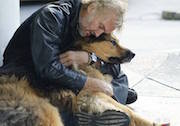 The local participating veterinarian must agree to do an exam and treatment(s) at a minimum 20-percent discount. The veterinary hospital/clinic is required to call, email or fax Pets of the Homeless an estimate for treatment after the initial exam. Program services are limited to: acute injury or illness, updating vaccinations during procedures, spay/neuter if authorized during procedures and euthanasia. Pets of the Homeless makes every effort to assist every pet as they are presented.
The local participating veterinarian must agree to do an exam and treatment(s) at a minimum 20-percent discount. The veterinary hospital/clinic is required to call, email or fax Pets of the Homeless an estimate for treatment after the initial exam. Program services are limited to: acute injury or illness, updating vaccinations during procedures, spay/neuter if authorized during procedures and euthanasia. Pets of the Homeless makes every effort to assist every pet as they are presented.
The emergency veterinary care process is as follows:
- The homeless person must pre-register for treatment with a Pets of the Homeless employee case manager.
- The Pets of the Homeless case manager contacts the veterinary hospital/clinic to pre-authorize the initial exam.
- After the initial exam, the veterinary hospital/clinic submits a treatment plan to Pets of the Homeless for approval. Which then an approval code is given.
- A Pets of the Homeless employee case manager reviews the treatment plan and any additional treatment.
- Pets of the Homeless is not responsible for any veterinary bill if prior approval is not secured by staff.
- Pets of the Homeless pays hospitals direct at time of service.
- Our Pets of the Homeless employee case managers are available between the hours of 9:00 a.m. - 3:00 p.m. (PST) Monday - Friday. Messages are returned the next business day.
- Pets of the Homeless uses the following criteria to determine homelessness: living in a transitional or emergency shelter, living in a campground, tent or vehicle, living in inadequate housing that lacks electricity, plumbing and heating or living in a motel (short-term 1-2 weeks at a time).
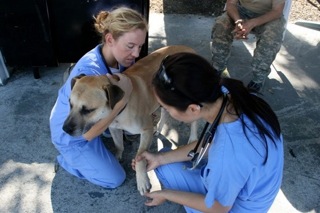 - Due to funding limitations, Pets of the Homeless programs do not include coverage of: dental cleaning, cremation services, non-core vaccinations, grooming, unnecessary lab work or x-rays, ongoing treatment, ongoing medications, boarding, pets with a diagnosis of cancer or diabetes and breeds (dogs and cats) over 14 years old.
- Due to funding limitations, Pets of the Homeless programs do not include coverage of: dental cleaning, cremation services, non-core vaccinations, grooming, unnecessary lab work or x-rays, ongoing treatment, ongoing medications, boarding, pets with a diagnosis of cancer or diabetes and breeds (dogs and cats) over 14 years old.
Emergency care is the most costly program due to the type of veterinary services needed to treat pets. Frequent diagnosis includes parvovirus, swallowed foreign objects, skin lesions, injured limbs, ear infections, lacerations and digestive issues. Treatment is costly because it often includes x-rays, lab tests, sutures, surgery and overnight stays.
Genevieve explains that participating veterinarians do get paid. They are just asked to give a 20 to 25-percent discount. Please talk to your own veterinarian and tell them about the program and ask them to contact Pets of the Homeless to participate.
Visit Website
The Dangers of Doggie Dragon Breath - Dr. Debbie
 Does your dog's breath cause you to gag and turn away? Are your pet's kisses unwelcome due to fetid breath? Many dog owners recognize that distinctive smell which is often accepted as a condition of dog ownership. But stinky dog breath, while common, is actually a symptom of illness and should not be ignored. Doggie dragon breath, just like a blinking traffic light, is a sign of danger ahead. Don't ignore dog breath for what it is - an indicator of oral infection that if left unchecked will impact your dog's health and shorten his lifespan.
Does your dog's breath cause you to gag and turn away? Are your pet's kisses unwelcome due to fetid breath? Many dog owners recognize that distinctive smell which is often accepted as a condition of dog ownership. But stinky dog breath, while common, is actually a symptom of illness and should not be ignored. Doggie dragon breath, just like a blinking traffic light, is a sign of danger ahead. Don't ignore dog breath for what it is - an indicator of oral infection that if left unchecked will impact your dog's health and shorten his lifespan.
What's the big deal about bad breath? It's more than just the smell. Bad breath, also referred to as halitosis, arises from plaque and oral bacteria. Periodontal disease progresses as plaque accumulates, mineralizes into tartar, and inflammation causes destruction of the supportive tissues around the teeth. Dogs don't simply get cavities, rather they will lose their teeth as connective attachments deteriorate. Untreated dental infections jeopardize the health of nearby teeth and may lead to osteomyelitis - infection in the bone. And with time, untreated periodontal disease showers the bloodstream with bacterial products leading to other diseases such as liver, kidney and heart disease.
Fight Halitosis
The best way to control periodontal disease is to assume an offensive attack. Monitor your pet's oral health by flipping up your dog's lip to discover what is lurking underneath. Look for red inflamed gums, yellow or brown accumulation on the teeth, tooth discoloration, or bad breath. Any symptoms of periodontal disease should be addressed with your veterinarian. Have your pet's teeth cleaned regularly at the veterinary office and follow up with home dental care including daily brushing.
These professional veterinary cleanings are important to safely remove mineralized tartar, clean under the gum line, permit a thorough oral exam and take x-rays. Veterinary dental x-rays are an essential tool in detecting problems and have been shown to identify oral disease in 28-percent of dogs and 42-percent of cats that have an outwardly normal mouth.
Don't fall into the hype about herbal spray-on products or 'awake' dental procedures - these only offer a cosmetic improvement in visible tartar, which only covers a small part of the tooth. These methods, often incorrectly touted as a safe alternative to professional cleanings, can't address the 60-percent of a dog's tooth which lies under the gum line - exactly where periodontal disease brews and does its damage.
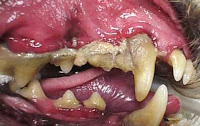 Once you identify that nasty doggie breath, you can be certain some degree of periodontal disease is present and dental intervention is needed. Statistics show that by 3 years of age 80-percent of dogs and cats already have periodontal disease. Don't forget that small and toy breeds of dog have accelerated dental problems diagnosed as young as 1 to 2 years of age.
Once you identify that nasty doggie breath, you can be certain some degree of periodontal disease is present and dental intervention is needed. Statistics show that by 3 years of age 80-percent of dogs and cats already have periodontal disease. Don't forget that small and toy breeds of dog have accelerated dental problems diagnosed as young as 1 to 2 years of age.
Think prevention - have your dog's teeth cleaned and embrace home dental care steps. And the next time you find yourself in a cloud of canine halitosis, you won't turn the other way - you'll grab that toothbrush.
Featured veterinarian known as "Dr. Debbie" on national pet radio program, Animal Radio. Ebook author of "Yorkshire Terriers: How to Be Your Dog's Best Friend"; "Pugs: How to Be Your Dog's Best Friend"; "Mini Schnauzers: How to Be Your Dog's Best Friend"; and "Shih Tzu: How to Be Your Dog's Best Friend." Dr. Debbie's books.
Visit Website
5 Ways To Up Your Pet Parenting Game During National Responsible Pet Owners Month
Robert Semrow, Listomania
 Taking on the lifelong commitment to care for a pet is more than an act of love, it's a promise of responsible actions for another living being. Since we can all step our game, here are 5 ways you can step up your Responsible Pet Ownership efforts:
Taking on the lifelong commitment to care for a pet is more than an act of love, it's a promise of responsible actions for another living being. Since we can all step our game, here are 5 ways you can step up your Responsible Pet Ownership efforts:
Let's start with something that isn't just being responsible, it's being smart. Be proactive by going around your house and pet proofing your home. When is the last time that you did that? Probably when you just adopted them in to your home. Whether that was last week or many years ago, your home has changed. Take a pet's eye view of your home now and see what temptations and dangers can be avoided. It may not only save your pet's life, it may save your pocketbook as well.
Next, take some time to research what your pets nutritional needs are. At one pet event, I was somewhat surprised to hear the answers to a question I posed to different pet owners, "What are your pets nutritional needs for your type of pet to thrive?" If you don't know, that's ok, but be responsible and seek out a pet nutritionist or expert and find out what your pet really needs. It will benefit both you and your pet to know what their nutritional needs really are.
Responsible health care habits is another area that many of us can step up our responsible pet parenting activities. This can range from regular grooming, to exercise, to an annual vet check-up. As a responsible pet parent we should be in contact with and/or observing our pets in close proximity for any changes in their health, both physical and mental. You are their pet health manager and you will need to make the call on which team member you need assistance for to care for your pet.
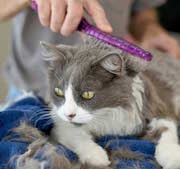 Another way to up your game is to learn something new with your pet. Whether it's an activity or way to give extra at home care, find something that you and your pet can embark on to improve their lives and enhance your pet parenting experience.
Another way to up your game is to learn something new with your pet. Whether it's an activity or way to give extra at home care, find something that you and your pet can embark on to improve their lives and enhance your pet parenting experience.
This last one is the easiest, but the one most often sacrificed. Responsible pet ownership requires time and prioritization. Just like children, your pets need to be at the top of your prioritization list and you must make the time to not only care for them, but to be a part of their lives. They are resourceful and forgiving, but they all want something that you can't buy or have someone else give them - you, your love and care.
Share your ideas on how to be the best responsible pet owner on our Animal Radio Facebook Page.
Visit Website
Animal Radio News - Lori Brooks
 Cat Plague Is On The Rise Is Australia
Cat Plague Is On The Rise Is Australia
We know there are pet parents who do not like to vaccinate their pets, but consider this parallel. The deadly cat disease feline panleukopenia, or "cat plague," is on the rise is Australia. This is significant because the sickness hasn't been an issue for cats down under for 40 years thanks to a vaccine developed during the 1970s. But in the last couple of years, cat plague has reemerged. Feline panleukopenia, or FP, is a highly contagious virus that attacks cells that rapidly divide like those found in bone marrow, intestines and developing unborn kittens. If the disease attacks and destroys bone marrow cells, the cats can no longer produce white blood cells, an important part of the immune system. Infected cats then often develop serious secondary infections. The virus can be transmitted through urine, feces or even fleas from other cats. It typically takes two days for an infected cat or kitten to become symptomatic, so the risk of transmission is extremely high.
 You Can Teach Older Dogs New (Computer) Tricks
You Can Teach Older Dogs New (Computer) Tricks
Researchers from the University of Veterinary Medicine in Vienna have found that older dogs benefit from playing computer games using a touch screen. Their new research shows it might stave off cognitive decline. The scientists found that brain training and problem solving can slow the pace of brain deterioration. However, the older dogs that could benefit from the training are rarely introduced to it. As we know, unlike puppies or young dogs, older dogs are almost never trained or challenged mentally, because senior dogs are usually perfectly integrated into our lives and we just forgive them for any disobedience or stubbornness. According to the new study, computer games paired with a reward system can replace demanding physical training and increase dogs' brainpower. This process was tested during the study in a laboratory and researchers say the next step is converting it to a living room-friendly format. The study compared computer games for elderly dogs to elderly humans doing Sudoku puzzles. The study says that as the dogs get older, we increasingly and unconsciously reduce the level of regular training. But the authors of the study emphasized that this isn't a favor to older dogs, because it restricts the opportunities to create positive mental experiences for dogs, which remain capable of learning even in old age. To be totally honest here, the researchers who worked on the study admitted that it was challenging to get dogs acclimated to using touch screens. But they say once the animals learned how to do it; they turn into avid computer gamers. And, some dogs are quicker to learn than others. Dogs that were bred to hunt, retrieve or herd are faster learners. Similarly, dogs bred to guard livestock or track scents are usually slower. Just remember if you try this, rewarding dogs when they take part in touch screen training is of the utmost importance. Experts say above all, the prospect of a reward is an important factor to motivate the animals to do something new or challenging. Regular brain training sorts dogs out of their apathy in old age, increasing motivation and engagement and thus maximizing learning opportunities.
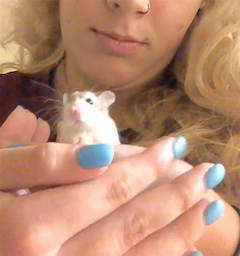 Airline Passenger Told To Flush Hamster Down Toilet
Airline Passenger Told To Flush Hamster Down Toilet
This story was one of the latest controversial case in airlines versus people seeking to travel with emotional support animals. It all began one Thanksgiving weekend when a beloved pet hamster was flushed down a toilet in an airport bathroom, supposedly after the airline, Spirit Airlines, refused to let a 21-year-old college student bring her pet hamster, Pebbles, on a flight as an emotional support animal. The woman's attorney accuses the airline of causing his client to tearfully flush Pebbles the hamster down a toilet after being denied a seat on the flight with the hamster. The woman says an airline employ suggested she flush the hamster, but the airline denied the accusation. As goes a lot of similar stories, the student says she was told over the phone by an airline employee that she could fly with Pebbles as an emotional support animal, but then would not let her on the flight with her hamster once she got to the airport. The young woman was a college student in Pennsylvania but was withdrawing from school due to a medical issue. She was flying from Baltimore where the incident happened, home to her parents in Florida. The airline said, "After researching this incident, we can say confidently that at no point did any of our agents suggest this guest (or any other for that matter) should flush or otherwise injure an animal." However, Spirit's spokesman did acknowledge that a reservation agent unfortunately, did misinform the guest that a hamster was permitted to fly as an emotional support animal on Spirit Airlines. In conjunction with the Federal Department of Transportation's guidelines, their website clearly states that it "does not accept snakes, other reptiles, rodents, ferrets and spiders," and that unusual animals or pets are to be evaluated on a case-by-case basis.
 Listen to the entire Podcast of this show (#1105)
Listen to the entire Podcast of this show (#1105)





